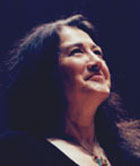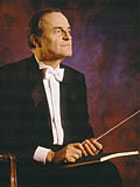|
|
|
[INDEX]
The Montreal Symphony Orchestra made its annual autumn pilgrimage to Carnegie
Hall this weekend with pianist Martha Argerich as headliner.
The Carnegie program on Saturday Oct. 27 was to have included Ginastera’s
Piano Concerto No. 1 as part of the all-Argentinean program but Argerich
switched to Tchaikovsky’s Piano Concerto No. 1, which the orchestra had
performed in Montreal on Oct. 23 & 24 with Russian pianist Andrei Gavrilov
(rumor has it Argerich didn’t want to learn the Ginastera from scratch).
 On
the evening of Saturday Oct. 27 Argerich was in her demoness phase. She
seemed distressed, as if performing under duress, and made faces on the
two occasions when she flubbed notes. It was one of those concerts where
her former husband, conductor Charles Dutoit, had to encourage and cajole
her from the podium, then try to keep up with her when she bolted from
the gate like a racehorse. Of course, Argerich is always worth hearing,
even when moody. Her Tchaikovsky was a titanic, momentous effort which
her dark, slightly loony virtuosity made especially gripping. On
the evening of Saturday Oct. 27 Argerich was in her demoness phase. She
seemed distressed, as if performing under duress, and made faces on the
two occasions when she flubbed notes. It was one of those concerts where
her former husband, conductor Charles Dutoit, had to encourage and cajole
her from the podium, then try to keep up with her when she bolted from
the gate like a racehorse. Of course, Argerich is always worth hearing,
even when moody. Her Tchaikovsky was a titanic, momentous effort which
her dark, slightly loony virtuosity made especially gripping.
Argerich played loud and fast, attacking the keyboard with the broad strokes
of a sculptor shaping a raw block of marble. Yet there were also flashes
of detailed whimsy: her solo passage in the first movement was syncopated,
almost jazzy. And she played the whole concerto at dizzying speed, as
if to prove she still has the chops. The Prestissimo was about as fast
as a human can play while still maintaining clarity and articulation.
The orchestra struggled to keep up with the diva’s rapid tempi and unpredictable
rubato. They framed her fireworks nicely, but made little statement of
their own.
Rumor had it that this was the first time Argerich played Tchaikovsky’s
Piano Concerto No. 1 in the USA. Argerich took five bows then dragged
the concertmaster offstage by the hand to end the show.
In the first half of the program the orchestra played four Argentinean
works: Ginastera’s Glosses sobre temes de Pau Casals (1977), Piazzolla’s
Concerto for Bandoneón and Orchestra (1979), Oblivion (1984), and Adiós
Nonino (1959). The Ginastera showcased the orchestra’s gossamer sound
and jewel-like wind and flute soloists. The Bandoneón Concerto was exotic,
nostalgic and melancholy, recalling the film scores of Nino Rota. The
little accordion played by Daniel Binelli sounded as bluesy as a saxophone
or trumpet. But the last two Piazzolla works were superfluous, swelling
an already long concert.
On Sunday Oct. 28 Argerich was in her angel phase, smiling and happy to
be on stage. Her friend Nelson Freire had withdrawn from the scheduled
Poulenc’s Concerto for Two Pianos due to tendonitis. So Argerich played
Beethoven’s Piano Concerto No. 1 instead. It was a rapturous experience.
Argerich was confident and masterful, delivering a carefully prepared,
superbly nuanced interpretation. She and the orchestra agreed on a chamber
music aesthetic, making the Beethoven sound like Haydn or Mozart. This
refinement, abetted by Argerich’s phenomenally delicate fingering and
phrasing, revealed unexpected depths of wit and color in Beethoven's famliliar
work. The Allegro was limpid, witty, and effortlessly commanding. The
Largo sounded as delicate as a lute song. The Rondo was simply Olympian,
a Gold Standard performance ending with pure, bell-like final notes. Throughout
the concerto Argerich highlighted melodies and rhythmic quirks that most
pianists overlook. I have never heard this concerto played so well, and
probably never will again. Argerich gave one of Schumann’s Kinderszenen
as an encore.
There was no sign of Argerich’s cancer which sidelined her last year.
She departed from her usual basic black and wore a dress and blouse with
a colored pattern. A good omen.
 After
the intermission Dutoit led the orchestra through all 80 uncut minutes
of Glière’s Symphony No. 3, aka "Il'ya Muromets" (1911). Despite the length,
it was an interesting piece with shades of Wagner, Mussorgsky, and Debussy.
The Montreal Symphony Orchestra’s expanded complement of 106 players gave
a sleekly professional reading of this vast musical mural. The strings
were silky and voluminous, the woodwinds pert and songful, the percussion
was well-blended. It was a first-rate performance of a second-rate work
we were glad to hear, once. After
the intermission Dutoit led the orchestra through all 80 uncut minutes
of Glière’s Symphony No. 3, aka "Il'ya Muromets" (1911). Despite the length,
it was an interesting piece with shades of Wagner, Mussorgsky, and Debussy.
The Montreal Symphony Orchestra’s expanded complement of 106 players gave
a sleekly professional reading of this vast musical mural. The strings
were silky and voluminous, the woodwinds pert and songful, the percussion
was well-blended. It was a first-rate performance of a second-rate work
we were glad to hear, once.
Both concerts were well-attended by a mixed audience, including pianists
Evgeny Kissin and Jean-Yves Thibaudet, but for the first time in years
Argerich’s name did not sell out the house.
The MSO's Carnegie Hall performances prove it is one of North America’s
top four orchestras, along with the Philadelphia Orchestra (especially
under Rattle and Dutoit), the National Symphony and Chicago Symphony for
contemporary music under Boulez, and the Pittsburgh Orchestra when Jansons
conducts. Montreal is justly proud of its band. What a tragedy that Canada's
best orchestra can only be fully appreciated when it leaves home and performs
somewhere with decent acoustics, such as Carnegie Hall.
Its Salle Wilfrid Pelletier home is a huge dry bunker that distorts music
and kills sound. The fact that the MSO is trapped there - like a pearl
in a rusty tin can - is the biggest scandal in Canada’s cultural life.
The Quebec government faithfully subsidizes the Montreal Symphony Orchestra
to the tune of several million dollars annually, but it won’t deserve
this gem of a band until it also bankrolls a proper auditorium to house
it.
> Carnegie Hall
> Montreal Symphony Orchestra
[INDEX] |
|
|

